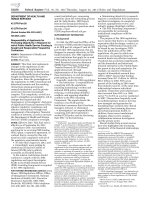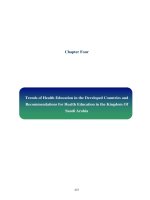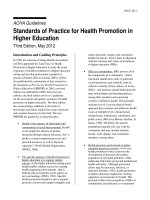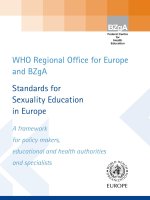Determinants of enrollment for secondary education in daklak province
Bạn đang xem bản rút gọn của tài liệu. Xem và tải ngay bản đầy đủ của tài liệu tại đây (2.45 MB, 93 trang )
UNIVERSITY OF ECONOMICS
INSTITUE OF SOCIAL STUDIES
HOCHIMINH CITY
THE HAGUE
VIETNAM
NETHERLANDS
VIETNAM- THE NETHERLANDS PROJECT FOR M.A. IN DEVELOPMENT ECONOMICS
DETERMINANTS OF ENROLLMENT FOR SECONDARY
EDUCATION IN DAKLAK PROVINCE
A thesis submitted in partial fullfilment of the requirements for the degree of.
MASTER OF ARTS IN DEVELOPMENT ECONOMICS
SUPERVISOR
: MA. NGUYEN HUU LOC
STUDENT
:PRAM TAN VIET
[!() GiAO O!JC vAr/,o Ti\0
TRLJ'C)NG DH KINH TE TP.HCM
T'HUVB~N
HO CHI MINH CITY, SEPTEMBER 2003
CERTIFICATION
"I certify that the substance of this dissertation has not already been submitted for any
degree and is not being currently submitted for any other degrees.
I also certify that to the best of my knowledge, any help received in preparing this
dissertation and all sources used, have been acknowledged in this dissertation".
Pham Tan Viet
Ho Chi Minh City, September 2003
i
ACKNOWLEDGEMENT
In order to obtain knowledge to complete this thesis, I am very grateful to Dutch
government for her financial support and scholarship during the two - year course.
I am greatly indebted to all project teachers and staff for their kindness. Particularly,
my thankfulness is given to Mr. Tran Vo Hung Son -the Project Director; Ms. Tran Thi
Ben - Project Deputy Director; Ms. Nguyet - the Project Secretary and Ms. Chi _,. the
Project Librarian.
High appreciation is given to Dr. Karel Jansen and Dr. Joudi Schipper for their valuable
comment of the thesis. I also thank all my classmates, especially Mr. Van and Ms.
Thuy who commented and contributed a lot of worthy ideas for my thesis research
design.
I would like to express my appreciation to M.A. Nguyen Huu Loc, who gave wholehearted help and gave me lots of useful advise in order to improve this paper. It will be
extremely difficult for me to accomplish this thesis without his help. His advise and
dedication play a key role for successfulness of this thesis.
My heartfelt gratitude is sent to Mr. Pham Van Chi - Eah'Leo Head of Education
Department; Mr. Nguyen Van Tuyen - Chairman of Eah'Leo District People's
Committee who helped me during the survey.
ii
ABSTRACT
This paper examines the role of household' s and child' s characteristics on the
decision to send children to go to secondary school in Eah'Leo district, DakLak
province. The results of this paper show that differences in household' s characteristic
affect children' s enrollment. The higher the per capita household income, the more
chance for children to go to school. Children' s characteristic consideration as child' s
ability is discovered to make sense remarkably concerning school decision. More
intelligent children are often received more education by their parents.
iii
ABBREVIATIONS
DSO
Dak Lak Statistical Office
MOET
Ministry of Education and Training
VLSS
Vietnam Living Standards Survey
VNSSFS
Vietnam Social Sector Financing Survey
EPH
Encuesta Permanent de Hogares
WB
The World Bank
UNDP
The United Nation Development Program
GSO
General Statistic Official
iv
CONTENT
Certification .................................................................................................................... 1
Acknowledgement ....................................................................... ,.................................. ii
Abstract ........................................................................................................................... iii
Abbreviation ................................................................................................................... iv
Content ............................................................................................................................ v
List of.tables .................................................................................................................... ix
List offigures .................................................................................................................. xi
CHAPTER 1 :INTRODUCTION ..................................................................................... !
I.
PROBLEM STATEMENT .............................................................................................
1
II.
OBJECTIVE AND SCOPE OF THE THESIS ...................................................................... 3
III. METHODOLOGY AND DATA COLLECTION ........ , ........................................................ .4
IV. LIMITATIONS OF THE THESIS ..................................................................................... 5
V.
STRUCTURE OF THE THESIS ........................................................................................ 5
CHAPTER 2:THEORETICAL FRAMEWORK .......................................................... 7
I.
DEFINITIONS ............................................................................................................. 7
II.
LITERATURE REVIEW ................................................................................................ 9
1.
The human capital theory........................................................................................... 9
2.
Theoretical models of Intra-Household allocation ................................................... 12
2.1
Unitary m.odels .................................................................................................... 13
v
2.1.1 The wealth model............................................................................................. 14
2.1.2 The separable earnings- transfers model ........................................................ 16
2.2 Bargaining models ............................................................................................... 18
3.
Models on intergenerational and intragenerational mobility................................... 19
4.
Other determinants of children's educational attainment ......................................... 21
III. THE EMPIRICAL STUDIES .......................................................................................... 22
IV. CHAPTER REMARK .................................................................................................. 25
CHAPTER3:0VERVIEW OF SECONDARY EDUCATION IN VIETNAM ........ 27
l.
RECENT TRENDS IN SECONDARY EDUCATION IN VIETNAM ..................................... 27
II.
DROP OUT RATE IN SECONDARY EDUCATION IN VIETNAM ...................................... 29
Ill. DESCRIPTIVE STATISTIC ON ENROLLMENT AND HOUSEHOLD INCOME ..................... 32
IV. CONCLUSION .......................................................................................................... 33
CHAPTER 4:DETERMINANTS
OF
ENROLLMENT
FOR
SECONDARY
EDUCATION IN.DAKLAK PROVINCE .................................................................... 34
OVERVIEW OF EDUCATION IN EAH'LEO DISTRICT, DAKLAK PROVINCE ................. 34
I.
1.
Introduction ............................................................................................................. 34
2.
Situation of school enrollment in Eah' Leo district in 2001-02 .................................. 35
3.
School Performance ................................................................................................. 35
DESCRIPTION OF VARIABLES .............................................................. :................... 36
II.
III. MODEL SPECIFICATION ........................................................................................... 41
IV. DATA COLLECTION AND PROCESSING ..................................................................... 44
1.
Data, data source..................................................................................................... 44
vi
2.
Sample size .............................................................................................................. 44
3.
Sampling technique .................................................................................................. 46
4.
Limitation of data collection .................................................................................... 47
V.
DESCRIPTIVE STATISTICS ........................................................................................ 47
1.
The relationship between enrollment rate and per capita household income ............ 48
2.
The relationship between enrollment rate and parents' years of schooling .............. 49
3.
The relationship between enrollment rate and number of sibling ............................. 49
4.
The relationship between enrollment rate and child's gender .............................. ,... 50
5.
The relationship between enrollment rate and child's age ...... :................................. 51
6.
The relationship between enrollment rate and child's ability ................................... 51
VI.
ECONOMETRIC ANALYSIS ....................................................................................... 52
1.
The regression result ............................................................................................... 52
2.
The regression diagnostic testing ............................................................................. 53
2.1
Testing the estimated z value and sign of estimated coefficients ........................... 53
2.2 Functional form test............................................................................................. 53
2.3 Testing for multicollinearity ................................................................................ 55
2.4 Goodness- of- fit test ........................................................................................ 56
2.5 Distribution of logit model......................... ~ ......................................................... 57
VII. COMMENTS ON THE ECONOMETRIC RESULTS .......................................................... 58
1.
Per capita household income level.. ......................................................................... 58
2.
Number of siblings ................................................................................................... 59
3.
Child's age .............................................................................................................. 60
4.
Child's ability ........................................................................................................... 60
vii
VIII. CHAPTER REMARK .................................................................................................. 61
CHAPTER 5:CONCLUSION AND RECOMMENDATIONS .................................. 62
APPENDIX
REFERENCES
viii
LIST OF TABLES
Table 2.1: Summary of the empirical studies ................................................................ 22
Table 3.1: Secondary School Enrollment in Vietnam in Selected Years, 1995-02 ..... 27
Table 3.2: Index of pupils at secondary school level (Previous year= 100) ............... 28
Table 3.3: Secondary education drop out rates, 1989-97 .............................................. 29
Table 3.4: Reasons for drop out at secondary school.. .................................................. 30
Table 3.5: Household Expenditure on Secondary Education per Pupils in 1997-98 ... 31
Table 3.6: Average Household Expenditure on Education by Region and Level of
Education ........................................................................................................................... 32
Table 3. 7: Net Enrollment Ratios by Income Quintiles ................................................ 33
Table 4.1: School Enrollment in Eah'Leo district in 200 1-02 ....................................... 35
Table 4.2: First Semester Performance School Year 2002-03 in Eah'Leo District ..... 36
Table 4.3: Transforming concepts into empirically measurable variables .................. 36
Table 4.4: Distribution of enrollment rate .................................................................... .47
Table 4.5: Prevalence of low enrollment rate indicator by per capita household
income ............................................................................................................................... 48
Table 4.6: Prevalence of low enrollment rate indicator by parents' years of schooling
................................. ;......................................................................................................... 49
Table 4. 7: Prevalence of low enrollment rate indiCator by number of sibling ............. 50
Table 4.8: Prevalence of low enrollment rate indicator by child's gender .................. 50
ix
Table 4.9: Prevalence of low enrollment rate indicator by child's age ....................... 51
Table 4.10: Prevalence of low enrollment rate indicator by child's ability ................... 51
Table 4.11: School enrollment logit estimates ................................................................ 52
Table 4.12: Logit estimates: unrestricted version of model ....... ;................................... 54
Table 4.13: Logit estimates: restricted version of model .................................... ~ .......... 54
Table 4.14: Correlation coefficients among explanatory variables ............................... 56
Table 4.15: Distribution of regression model .................................................................. 57
Table 4.16: The estimated probability that a child aged 11-17 goes to school 1 ............. 58
X
LIST OF FIGURES
Figure 2.1: The relationship between wage rate and years of schooling for persons with
different abilities ............................................................................................................. 11
Figure 4.2: Logit and probit cumulative distributions ................................................... 43
xi
CHAPTER 1:
I.
INTRODUCTION
Problem Statement
Almost countries recognize the key role played by human capital for national growth
and development, especially education. The East Asia tigers including Hong Kong,
Singapore, South Korea and Taiwan achieved the sustainable high rates of growth
about 6-7 per cent per year for four decades. This success is paralleled with sustainable
growth in formation of skill (Ashton et al, 1999). Recognizing this importance after
achieving independence from colonialism new governments of developing countries
embark on building schools. As a result school enrollments increased rapidly from
nearly 100 millions in 1950 to 764 millions by 1990 at all levels of education (Gillis et
al, 1996). There are lot of empirical evidence suggested the relationship between
education investment and enhancing economic growth in developing countries. For
example, contribution of education to economic growth was wide range of 1 to 3
percent in Mexico, Brazil, and Venezuela to .16 percent in Argentina (lfaddad, W.D, et.
al., 1990:3). According to Law of Education in 1998 education has been considered as
the first national priority policy in the process of industrialization and modernization to
repel poverty in Vietnam.
The most sensible feature in low-income countries is that a large population depends
on agricultural production, around seventy per cent (Gillis et al, 1996). Vietnam is not
1
exceptional case with about eighty per cent population in agriculture (WB, 1999c).
However, agricultural yield is strongly dependent on natural condition (i.e. weather
condition). This may result in low and unstable level of income of households. Even a
good yield is not sure to bring higher household income due to fluctuated price of
agricultural products. It is believes that there is a strong relationship between education
and income at individual (Blau, 1996). Education will increase capacity of earning
money and employment opportunity (Haughton et all, 2001). Hence, a way to improve
household income and to resist poverty is that people try to get as much amount of
schooling as possible for their children and themselves,
The Vietnam education level, which can be measured by enrollment rate, began to
decline in the late 1980s (Glewwe and Jacoby, 1998). In the Central Highlands Region,
where considers as one of the least developed areas in Vietnam, its net enrollment
ratios for secondary school ranks second to last just above Mekong River Delta, 38 per
cent compared with 29 per cent (WB, 1997). Thus, the problem arises here is that
whether a low secondary education in mountain areas is due to low and flexible level
of household income. There exists a cycle in which a well-educated person have more
chance to get higher earnings, which, in tum, encourage him or her to get as high
education as possible because formal education contributes important role in
individual's earnings. The higher an individual's educational attainment, the higher
expected starting salary that individual can earn (WB, 1996). Therefore, this study will
2
examine the impact of household income level on enrollment in secondary school in
Daklak province because whether a low secondary school enrollment rate (19 per cent)
in DakLak province (DSO, 2001) is caused by low per capita about VND296;000 per
month in 1999 (DSO, 2001). The purpose of this study is to find out whether there
exists any causality between the level of household income and a child's enrollment
rate and why enrollment rate is still low in secondary school in Daklak province. This
thesis focuses on topic 'Impact of level of household income on enrollment in
secondary school in Daklak province'. The topiC is fairly important because secondary
education provides basic skills for further individual's study. Moreover, investment in
children's education may be the base to break down vicious cycle of poverty
transmitted among generations and spurs national growth and economic development
(Jensen, 2000).
II. Objective and scope of the thesis
This study was under taken to specify the impact of level of household income on
parents' making-decision in sending their children to school at the secondary level.
In other words, this thesis focuses on answering following research questions:
(i)
Is there a positive relationship between per-capita household income and
enrollment of secondary school in Daklak province?
3
(ii)
Whether child's ability influences on parents' making-decision in sending
children to secondary school in Daklak province or not?
The above research questions are based on the following hypotheses:
(i)
There is a positive relationship between per-capita household income and
enrollment of secondary school in Daklak province, and
(ii)
Child's ability influences on parents' making-decision in sending children to
secondary school in Daklak province.
III. Methodology and data collection
This study tries to clear up the above said objectives by the theoretical models of
household economics and the previous empirical studies. Beside the descriptive
method, which provides a picture of Vietnam secondary education through collecting
tertiary data of the World Bank, UNDP, and others in general and the status of
secondary enrollment rates in Daklak province in particular, the legit regression
technique is also used in order to analyze the data of this study.
This research considers whether a child will go to school or not, particular in secondary
level. Each child within the secondary school age, 11-17 years old is considered as a
sample unit in this study. A cross-section data set of individuals of households is used in
order to explore the school attainment decision based on mainly the impact of per
capita income of households.
4
Daklak province is chosen to examine this study instead of VLSS 1992 - 93 and VLSS
1997 - 98 because faster and faster development might make VLSS data become
already old. Moreover, a variable which proxies for child's ability is not available in
VLSS 1992-93 and VLSS 1997-98.
IV. Limitations of the thesis
There are two approaches in the theory: static model and dynamic model. The latter is
the better approach for the topic relating to education. However, the study is just likely
to use static approach since limitation of time and budget constraint.
Human capital is multi-dimensional. It includes education, health, nutrition, on-the-job
training, experience, skills and migration. This study only focuses on education aspect
of multi-dimensional human capital.
V. Structure of the thesis
The thesis is divided into five chapters as follows:
The introduction followed by. chapter two which presents the definition of education
and its measurements. The theories about household economics and about the human
capital will be reviewed. The determinants of enrollment of the previous studies will
be summarized on which potential determinants of school enrollment are derived at the
end of this chapter.
5
Chapter three has a look the picture of secondary school enrollment of Vietnam in brief
and of DakLak province in more detailed. In this chapter descriptive statistic will be
used in order to support stronger for arguments figured out.
Chapter four is the main chapter. Starting by data description. Then, econometric
model is specified to test the above potential determinants. This chapter is closed by
commenting on the regression results.
Chapter five will summarize the main findings from the thesis on which some plausible
policy implications and further study are suggested.
6
CHAPTER 2:
THEORETICAL FRAMEWORK
This chapter is opened by necessary definitions of education and its types, income
effect and enrollment as well. Then, in order to understand the relationship between
per capita household income and children enrollment of secondary school, it is
necessary to examine the general theory of the human capital, intra-household
behaviour, and household production before exploring much more specific models
relating to the two-period model .of the demand for formal education, wealth model,
separable
earnings-transfers
model
and
models
on
intergenerational
and
intragenerational mobility. After this an examination of the empirical studies on the
relationship between household income and school attendant will be discussed. Finally,
this chapter is closed by chapter remarks section
I.
Definitions
Education: according to Gillis et al (1996), in term of broad aspect education is all
forms of human learning or more narrow sense it is the process that takes places in
specialized institution called "school". And Gillis et al divided education into three
types:
Formal education occurs in institutions called school and its subject is young people
who have not started working for their living yet. It consists of basic or general, tertiary
and university or higher education. Secondary education belongs to this kind of
education, that is, continues to provide more skill-oriented instructions for children of
7
the eleven-seventeen age group, who are expected to enter into upper education levels
by more highly professional teachers.
Non-formal education is the process of study outside school and aims at adults. The
curricula are usually shorter, narrower and more connected with applied knowledge
than those of formal education with such subjects as literacy, household life, or
citizenship.
Informal education studies that happens neither school nor organized program.
Knowledge people is accumulated during their .life through work in the community and
self-studying at home.
Income effect: the consumer's real income will change as the price of goods increases
or decreases. Meanwhile, It is expected that consumers will buy less or more goods
which has changed its price (Pearce, 1992: 196).
Enrollment ratio (gross): is calculated by dividing the total number of pupils, which are
within or out off the official school age group, by the population according to official
regulations. The gross ratio may exceed 100 per cent because some pupils are below or
above the official school age group (WB, 1996).
8
II. Literature review
1. The human capital theory
Economic theories on the determinants of investment in education usually start with the
human capital theory of Becker (1964). The assumption under human capital theory is
an increase in income and productivity. The addition income and output in the future
can be ascribed by return of investment. Whereby, investment in education depends on
the costs and benefits which are brought from investment in human capital. Costs
include both direct expense associated with schooling such as books, fees, etc. and
indirect costs like opportunity costs which are usually considered as forgone earnings
during the time at school. Whereas, benefits refer to the increasingly present value of
lifetime earnings. The parents will therefore made decision to invest in education for
their children only if discount benefits are larger than discount costs. In contrast, the
investment in education for their children is not done.
There have been some important findings drawn from researches in this field: (i) the
rate of return on investment in education is higher than that of return on other
investments; (ii) schooling decision of individuals is based on expected returns; and (iii)
individuals who have more ability and higher capability of success is in favour of
investment relative to persons with less talent and ability (Kooreman and Wunderink,
1997).
9
The human capital theory is general framework on which there are a lot of human
capital models to be established, especially in education. One of such models is twoperiod model of the demand for formal education.
Two-period model of the demand for formal education (Kooreman and Wunderink,
1997)
In most countries elementary education is nearly free of charge by government
~upport
of education (Kooreman. and Wunderink, 1997). Therefore, after completing
elementary education individuals can either continue to go to school or stop arid start
working.
Human capital models mainly focus on the relationship between capability of earning
per hour, w, and someone's stock of human capital, HC. In particular this is the
relationship between wage rate and schooling which is studied in most applied work.
The two-period·models show that after completing elementary schooling if individuals
invest t hours at school in the first period and then their stock of human capital will
increase time by time. At the second period, their wage rate is higher because they
have higher stock of human capital as a result of investing in education in the first
period. Individuals decide to continue studying after completing elementary because
they expect to gain higher salary in the future.
According to Kooreman and Wunderink (1997) at the beginning of the second period
the stock of human capital (HC2) and wage rate (w 2) would be:
10
HC2
w2
= (1 - o)HC1 + dHC(ts, A)
(1)
= w2(ts, HC1. o, A)
(2)
Where:
HC 1: stock of human capital after leaving obligatory education
ts: the time spent on education
A: person's abilities
o: depreciation of human capital (i.e. people forget things time by time)
If HC1. and o are exogenous. As a result w2 only is effected by ts and A.
The relationship between wage rate, w 2; schooling time, ts; and abilities, A as follow:
(3)
with following assumptions:
2
2
8w2/8ts > 0: 8 w2/8t s < 0 and 8w2/8A > 0 as illustrated in Figure 2.1 (Willis,
1986) below:
Log earnings
'S!
Years of schooling
Figure 2.l:The relationship between wage rate and years of schooling for persons with
different abilities (Willis, 1986)
11
The two-period model of demand for formal education is able to interpret that
investment in education originates from· higher expected earnings in the future.
However, the human capital theory in general and the two-period model of the demand
for formal education in particular still reveal limitations. Both ignore a consumption
aspect of education. Individuals who invest time and money just satisfy their curiosity
and interest, instead of higher expected earnings. For example, when they learn how to
swim or to prepare a delicious meal it is obvious that this investment does not bring
higher expected returns rather than their greater level of utility (Kooreman and
Wunderink, 1997). In addition, households often face a problem of budget constraint.
Parents cannot afford to invest on their children although they perceive that those
children have certain abilities and higher expected earnings. The intra-household
allocation models help to resolve a problem of constraint resource in the households.
2.
Theoretical models of Intra-Household allocation
Intra-household allocation models provide household resource allocation decisions.
There exists inequality among household members, gender difference in investment in
children's schooling for instance. Psacharapolous and Arriagada (1989) showed that
there is a bias in favour of girls to school attendance in Brazil. These models permit the
income, educational levels of differential people in the household to have different
impacts on outcomes (Thomas, 1990). Generally, preference of the parents play an
important role in determining the level of investment in children. The two more
12
specific models, namely, unitary models and bargaining models will be discussed
particularly.
2.1 Unitary models
The outstanding character of the unitary models is to use a single utility function for the
household. All household members have the same utility function. Hence, maximizing
the household utility function is in fact to maximize individuals' utility function. The
main assumption under unitary model is that there is not conflict within the household's
members, that is the identical preferences. Considering parental investment in children
which assumes a parental utility function as follows (Behrman, 1996):
U
= U(Cp, Yi, Ti)
(i= 1 ..n)
(4)
Where
Cp = parental own consumption
Yi =the adult income of each child
Ti = the size of transfers to each child by parents
The parents maximize their utility function with subject to two constraints: a parental
budget constraint and the earnings production function for each child. The second
constraint is a function of human capital investment to each child by parents and child's
initial endowment.
Yi = Y(Hi, Ai)
(5)
Where
13









